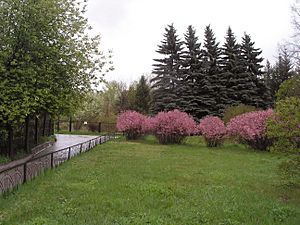Prunus pedunculata facts for kids
Quick facts for kids Prunus pedunculata |
|
|---|---|
 |
|
| This picture shows P. pedunculata with its bright pink flowers at the Botanic Garden of the Irkutsk State University. Notice how the lower part of the bushes has bare stems, which helps catch soil blown by the wind. | |
| Scientific classification |
Prunus pedunculata is a type of plant in the Prunus family, which includes cherries, plums, and almonds. In China, it's known as the long-peduncled almond. This name comes from its long stems that hold the flowers and fruits.
This interesting plant grows naturally in parts of China, especially the Inner Mongolia Autonomous Region. You can also find it in Mongolia and nearby areas of Siberia.
Contents
What is Prunus pedunculata?
Prunus pedunculata is a small bush that usually grows to be about 1 to 2 meters (3 to 6 feet) tall. It has beautiful pink flowers that make it a popular choice for gardens.
Where Does it Grow?
This plant is super tough! It's perfectly suited for cold and dry places, like deserts or steppes. It can handle very cold winters and doesn't need much water.
How it Helps the Environment
One of the most important things Prunus pedunculata does is help the environment. It has many stems that grow close together. This special growth helps to catch sand that is blowing in the wind. By doing this, it helps stop sand dunes from moving around too much.
This ability to "fix" or stabilize blowing sand is very important for something called ecological succession. This is how new plants start to grow in an area that was once bare or damaged. Prunus pedunculata acts like a pioneer plant, making it easier for other plants to grow later.
Uses of Prunus pedunculata
Besides being a pretty ornamental plant, scientists are also looking into other uses for Prunus pedunculata.
Seed Oil Potential
Researchers are studying the seeds of this plant to see if they can be used to make oil. This oil could potentially be useful for different purposes, similar to how oil is extracted from other almond varieties.
Life Cycle and Reproduction
Like many plants, Prunus pedunculata reproduces using its flowers and seeds. Its bright pink flowers attract pollinators, which helps the plant create seeds. These seeds then grow into new bushes, continuing the life cycle.

